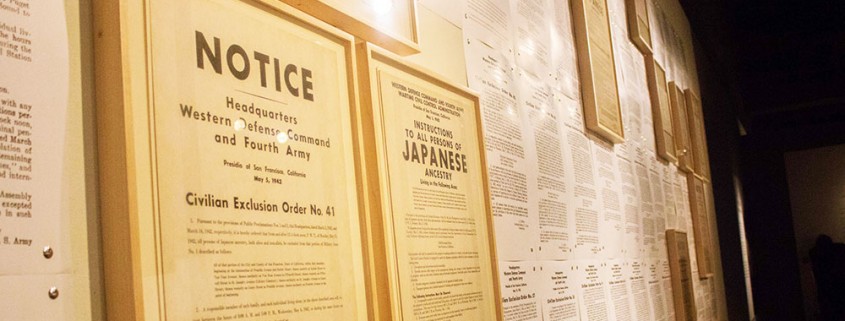75 years later, art remembers past injustices
“With liberty and justice for all.”
George Takei remembered repeating this phrase from the Pledge of Allegiance, like many Americans, since he was just a schoolboy. His experience with liberty and justice, however, was markedly different than the average American.
“I could see the barbed wire next to the center tower, right outside my schoolhouse perimeter, as I recited the words, ‘With liberty and justice for all,’” Takei said at a press conference on Friday.
Takei was one of the 120,000 Japanese Americans forcibly interned within segregated camps under President Franklin D. Roosevelt’s executive order issued in 1942.
Seventy-five years later, Takei is now a renowned actor, social activist and chair emeritus of the Japanese American National Museum in Los Angeles. On Friday, he introduced the opening of its latest exhibition, Instructions to all Persons: Reflections on Executive Order 9066.
The exhibition has been in the works for many years and aims to commemorate the incarceration of Japanese Americans seven decades ago, but according to curator Clement Hanami, its sociopolitical significance draws parallels with the current political climate.
The historic documents of Presidential Proclamation 2537 — Roosevelt’s executive order and legislative precursor to the order — was funded by the Broad Foundation. The Foundation sponsored the transportation of the papers from Washington, D.C. to Los Angeles.
“We cannot forget the immoral injustice executive orders can inflict,” the Broad Foundation President Gerun Riley said.
The two pieces are on display at the heart of the exhibit, past narrow, dark corridors. There, Roosevelt’s typed order hangs, magnified and heavy with historical consequence, above a glass case of the original signed documents.
Gentle music beckons the viewer inside the dimmed setting of the exhibit’s walkway to a small theater that replays the internment testimonials of many Japanese Americans. Their voices resonate beyond the dark, secluded space, perceptible even deeper inside. Although the testimonies soon fade off into the distance, a black-and-white wall filled with Kodak photographs of Japanese testifiers visually amplifies their harsh reality, even without sound present.
“Have you been told your story is not important?” is written in thin orange text, interrupting the rows of Kodaks with its bold statement. Another installation is displayed parallel to it, but with the words, “What is your story?” written in between the images.
The main room of the exhibit contains hundreds of historical leaflets, newspaper clippings, books and documents scattered in glass cases with wooden lining. The wood and the yellowed pages of documents give the room a warm glow, but upon closer inspection, the significance of the displayed pieces is haunting.
“INSTRUCTIONS TO ALL PERSONS OF JAPANESE ANCESTRY.” The bold statement was issued as a direct command; on the exhibit’s center wall hang the framings of multiple civilian rules and exclusion orders that hindered Japanese Americans’ rights and eventually led to their internment. The legislative orders patched up the entire surface of the wall, with key orders enlarged and held in restrictive wooden frames.
“At that time, [Japanese Americans] were all classified as enemy aliens,” said Bill Shishima, a USC alumnus who lived at the Santa Anita camp as an 11-year-old. “I was a young American citizen, but no — where the government was concerned, I was an enemy alien. This exhibit spells out all the details, all the executive orders that pertain to that [belief].”
A powerful visual timeline extends alongside the walls adjacent to the center installation, illustrating the progression of discriminatory legislation enacted during the early 1940s. The horizontal sequencing of the timeline invited viewers to walk through this path of history, outlined with significant quotes from Japanese Americans, contentious court cases and internment locations throughout the years.
At the end of the timeline, the viewer is confronted with three hanging sculptures — a loosely hung mass consisting of hundreds of paper tags that were once issued to detained Japanese individuals. The sculptures rustled in the air-conditioned breeze inside the museum, but otherwise, they appeared lifelessly wrinkled and melancholy — left-behind memories no one wanted to reclaim.
Though somber in mood, the final installation of Instructions to All Persons casts a hopeful light on the progressive ideologies held by Americans today. It is a video that features a diverse group of young Americans reading letters written by children in internment camps to the outside world.
It is a touching video that preaches unity through a simple concept — having children today read the letters of children from the past and realize that they share more than they differ.
Richard Murakami, a USC alumnus whose childhood was largely affected by Executive Order 9066, reflected on the importance of understanding and empathy from the public to prevent these American tragedies.
“We believe in this exhibit because it tells the public about what happened 75 years ago,” Murakami said. “The reason why we have this museum … is because we don’t want this to happen again.”
Instructions to All Persons will be open at the Japanese American National Museum from Feb. 18 to Aug. 13. The original Executive Order 9066 with Roosevelt’s signature will be on display through May 21.

